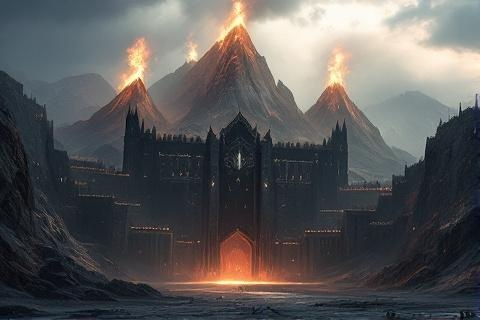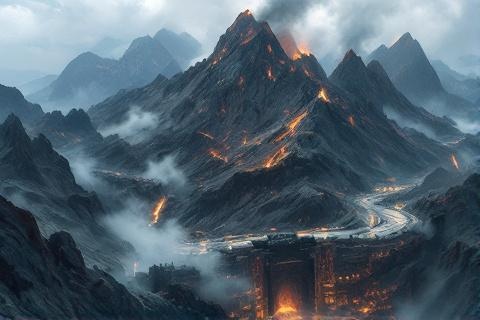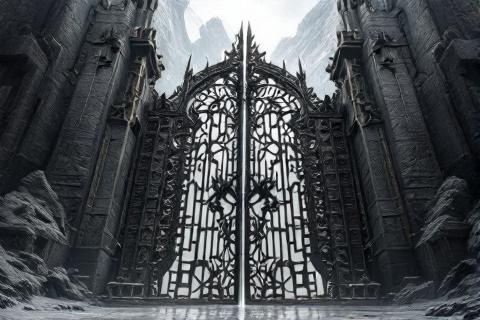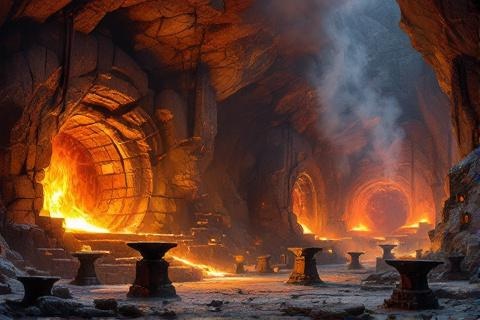
Unveiling Angband: The Fortress of Morgoth
A Deep Dive into Tolkien's Most Terrifying Bastion of Evil
The Iron Mountains' Crown: Location and Scale of Angband

Angband stood as a monument to darkness in the frigid wastes of the far northern
reaches of Beleriand, its presence marked by the three mighty peaks of
Thangorodrim that Morgoth raised above it. These colossal
mountains, fashioned from the heaped slag and refuse of Angband's delving,
soared into the sky as the highest peaks in Middle-earth,
their summits perpetually shrouded in dark clouds and volcanic fumes.
The fortress itself was ingeniously constructed within the formidable Iron
Mountains, making it virtually impenetrable to assault. Morgoth, learning from
the destruction of his previous stronghold Utumno, ensured that
Angband was built to withstand even the might of the Valar
themselves, embedding it deep within the living rock of the mountains.
The true extent of Angband's subterranean realm remained unknown to even
Morgoth's greatest enemies, with its network of tunnels and chambers extending
countless leagues beneath the earth. These passages twisted and delved ever
deeper, creating a labyrinthine complex that housed Morgoth's armies, forges,
and dungeons, while its deepest reaches held horrors unknown to any save its
dark master.
Architecture of Evil: The Fortress Design

The Great Gate of Angband stood as a towering portal of black iron and steel,
wrought with dark enchantments and guarded by companies of Orcs,
werewolves, and Balrogs. This main entrance, positioned beneath the central peak
of Thangorodrim, was designed to withstand siege engines and magical assault,
while serving as a swift means of deploying Morgoth's armies.
The dungeons of Angband descended in terrible levels, each more horrific than
the last, where countless prisoners suffered in darkness. These prison levels
housed many of the First Age's greatest heroes and most tragic figures,
including Húrin Thalion, who was chained upon Thangorodrim's heights, and
Maedhros, who was hung from a sheer cliff face by a band of steel.
The great halls of the fortress were carved directly from the living rock of the
mountains, their walls smooth and black as glass from the intense heat used in
their making. These vast chambers served as gathering places for Morgoth's
armies and housed his countless slaves and servants, their scale demonstrating
the immense power of their creator.
The defensive tunnel system of Angband was deliberately designed to disorient
and trap unwary intruders who might breach its outer defenses. These passages
were riddled with dead ends, false paths, and clever traps, while also allowing
Morgoth's forces to move swiftly through secret ways known only to them.
The Pits of Angband
The deepest dungeons of Angband extended far beneath the roots of the Iron
Mountains, where Morgoth imprisoned his most valuable captives and conducted his
most terrible experiments. These lightless pits witnessed the corruption of
captured Elves into Orcs and housed creatures of shadow and flame
that never saw the light of day.
The slave quarters and forges occupied multiple levels of the fortress, where
countless thralls labored endlessly to produce weapons and armor for Morgoth's
armies. These spaces were filled with the constant sound of hammers, the heat of
forges, and the misery of the enslaved, who worked until death under the cruel
oversight of Orcs and other servants of darkness.
Deep within Angband's secure vaults, Morgoth hoarded his greatest treasures,
including the two remaining Silmarils he had stolen from
Fëanor. These storage chambers were protected by powerful
spells, fearsome guardians, and layers of deception, making them nearly
impossible for any outsider to locate or breach.
Throne Room of the Dark Lord

The throne hall of Morgoth was perhaps the most terrifying chamber in all of
Angband, carved from black stone that seemed to absorb light rather than reflect
it. Its vaulted ceilings rose so high they were lost in shadow, while pillars
thick as ancient trees supported the massive weight of the mountain above.
Upon a great dais of black stone sat Morgoth's iron throne, from which he
directed his wars against the Elves and Men of Beleriand. The
throne itself was a masterwork of dark craftsmanship, adorned with evil symbols
and enchantments, while the Iron Crown containing the stolen Silmarils rested
upon Morgoth's head as he sat in terrible majesty.
The hall was perpetually lit by great pits of fire that cast wild, dancing
shadows across the walls and floor. These flames provided no true warmth but
instead seemed to deepen the darkness, creating an atmosphere of dread that few
could endure without trembling.
Defenses and Fortifications

Angband's outer defenses consisted of multiple rings of impossibly high walls
and towers, each more formidable than the last. These fortifications were manned
by countless Orcs and evil creatures, while dragons perched
upon the heights of Thangorodrim itself, providing aerial surveillance and
defense.
The narrow passes leading to Angband were heavily fortified with watchtowers and
strongpoints, forcing any attacking army to advance through carefully controlled
channels where they could be easily attacked from multiple positions. These
defensive positions proved crucial during the numerous battles of the First Age,
including the devastating Nirnaeth Arnoediad.
The natural defensive position of Angband was further enhanced by its
integration into the Iron Mountains, making it nearly impossible to approach the
fortress except through carefully guarded passes. The sheer cliffs and
treacherous terrain provided natural barriers that even the most determined
armies struggled to overcome.
Surrounding the fortress were vast chasms and moats filled with volcanic fire,
creating an additional ring of defense that few could hope to cross. These
burning trenches were fed by the same underground fires that powered Angband's
forges, their heat and toxic fumes providing yet another layer of protection for
Morgoth's stronghold.
The Forges of Angband

The smithies and workshops of Angband were countless in number, each dedicated
to producing different components of Morgoth's war machine. These facilities
created everything from basic weapons and armor to sophisticated instruments of
war and torture, their production never ceasing throughout the long years of the
First Age.
The great furnaces of Angband burned with supernatural intensity, powered by
fires from the heart of the earth itself. These massive forges were used to
create Morgoth's most powerful weapons and to refine ores mined from the depths,
their heat so intense it could melt any metal known to Elves or Men.
An intricate system of ventilation shafts carried the smoke and fumes from
Angband's countless forges up through the peaks of Thangorodrim. These emissions
created a perpetual pall of darkness over the fortress and the surrounding
lands, contributing to the region's reputation as a place of death and shadow.
Passages and Secrets
Throughout Angband's vast complex, hidden exits known only to Morgoth's most
trusted servants provided escape routes and secret ways to deploy troops
undetected. These concealed passages were especially valuable to creatures like
Thuringwethil the vampire-messenger and other spies who needed to move swiftly
and secretly in Morgoth's service.
The maze-like corridors of Angband were deliberately designed to confuse and
trap unwanted visitors, with certain passages subtly sloping downward to lead
intruders ever deeper into the fortress. These architectural tricks, combined
with magical deceptions, ensured that few who entered uninvited ever found their
way out again.
Secret chambers throughout Angband housed Morgoth's most precious possessions
and his most terrible weapons, including the many evil artifacts he had created
during his rebellion against the Valar. These rooms were protected by both
physical and magical barriers, their locations known only to the Dark Lord
himself.
Legacy in Stone and Steel
The architectural design of Angband served as a template for later evil
fortresses in Middle-earth, most notably Sauron's tower of Barad-dûr. The
combination of natural and constructed defenses, the use of underground
chambers, and the implementation of dark sorcery in its construction would all
be echoed in the evil strongholds of later Ages.
As a symbol of Morgoth's power, Angband represented the ultimate corruption of
Arda itself, where the very substance of the earth was twisted to serve evil
purposes. The fortress stood as a perversion of the natural order, its very
existence an affront to the original Music of the Ainur and the plans of
Ilúvatar.
The physical might of Angband served as a testament to Morgoth's position as the
first and greatest Dark Lord of Middle-earth. Its ability to withstand centuries
of siege and assault demonstrated the tremendous power of its master, while its
eventual destruction in the War of Wrath marked the end of the First Age and
Morgoth's dominion over Middle-earth.
